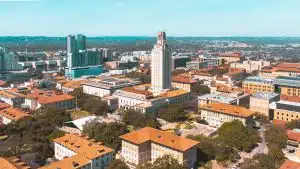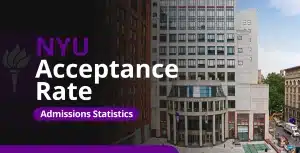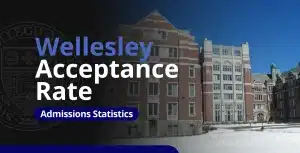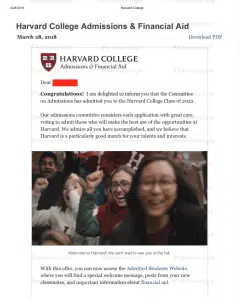Getting into the University of Virginia (UVA) just got even tougher. For the Class of 2028, UVA hit a record-low acceptance rate of 16.8%, the lowest in a decade. But that’s not surprising at all. UVA is one of the Public Ivies (basically, public schools with Ivy League-level prestige), and it recently climbed to the #4 spot among the top public universities in the U.S. With a reputation like that, it makes sense that getting admitted is only getting harder.
If UVA is on your list, you’ll want to keep these numbers in mind. Knowing how competitive it is can help you plan a solid and realistic application strategy. That’s why in this blog, we break down important admission stats including UVA’s overall acceptance rate, Early and Regular Decision rates, transfer and waitlist data, and analyze what these numbers mean for your chances of getting in.
- What Is the University of Virginia’s Acceptance Rate?
- University of Virginia Acceptance Rate Trends
- University of Virginia Regular Decision Acceptance Rate
- University of Virginia Early Decision Acceptance Rate
- University of Virginia Early Action Acceptance Rate
- How to Get Accepted into the University of Virginia
- University of Virginia Transfer Acceptance Rate
- University of Virginia Waitlist Acceptance Rate
- Frequently Asked Questions
- Takeaways
What Is the University of Virginia’s Acceptance Rate?
For the Class of 2028, the University of Virginia reported a total acceptance rate of 16.8%, with 9,909 accepted students out of 58,951 applicants. Moreover, looking closer, how you apply can change your odds:
| Application Type | Total Applications | Total Accepted | Acceptance Rate |
| Early Decision | 4,971 | 1,282 | 25.8% |
| Regular Decision | 54,486 | 8,776 | 16.1% |
| Overall | 58,951 | 9,909 | 16.8% |
As you can see, if you applied Early Decision (ED), you had better odds—25.8% got in, which means 1,282 out of 4,971 ED applicants were accepted. But Regular Decision (RD) was tougher, with an acceptance rate of 16.1%. A total of 54,486 students applied through RD, including those deferred from ED and Early Action (EA), but only 8,776 were offered a spot.
Here’s something interesting: UVA is committed to keeping two-thirds of its student body from Virginia, but most applicants—about two-thirds—are from out of state. Because of this, Virginia residents have a much higher chance of getting in.
For the Class of 2028, UVA got 42,487 out-of-state applications but only accepted 5,640 students or an acceptance rate of just 13%. Meanwhile, 16,464 Virginia residents applied, and 4,269 were accepted, a much higher 26% acceptance rate. So, if you’re applying from outside Virginia, expect the competition to be even tougher.
UVA also offers Early Action (EA), but they haven’t shared the latest numbers for that yet. If you’re wondering how EA compares to ED and RD, you’ll have to wait a little longer for those stats.
One thing is clear from the numbers—applying ED gives you a better shot. But even with that advantage, getting into the University of Virginia is still challenging. You’ll need a strong, well-polished application to stand out.
University of Virginia yield rate
A school’s yield rate shows how many admitted students actually decide to enroll. For UVA’s Class of 2028, the yield rate was 40%, meaning 3,961 out of 9,909 accepted students chose to attend.
Over the past five years, UVA’s yield rate has stayed pretty consistent, ranging from 39% to 42%. Here’s a look at the school’s yield rates over the years, based on its Common Data Set.
| University of Virginia Class | Total Accepted | Enrolled | Yield Rate |
| 2028 | 9,909 | 3,961 | 40% |
| 2027 | 9,533 | 3,966 | 41.6% |
| 2026 | 9,503 | 4,021 | 42.3% |
| 2025 | 9,951 | 3,889 | 39.1% |
| 2024 | 9,230 | 3,785 | 41% |
This consistency suggests that UVA has a strong appeal among admitted students, with a reliable percentage choosing to attend each year. A stable yield rate like this indicates that UVA is maintaining its reputation, attracting students who are genuinely interested, and successfully converting admits into enrolled students.
For context, the national average yield rate for four-year nonprofit colleges in fall 2022 was around 30%. Private colleges did slightly better at 33%, while public colleges averaged 25%. UVA’s 40% yield rate is well above the public college average, showing that many admitted students see it as their top choice.
University of Virginia Acceptance Rate Trends
The University of Virginia’s acceptance rates have been dropping over the past five years, and this year hit the lowest point yet:
| University of Virginia Class | Total Applications | Total Accepted | Acceptance Rate |
| 2028 | 58,951 | 9,909 | 16.8% |
| 2027 | 56,528 | 9,533 | 16.9% |
| 2026 | 50,926 | 9,503 | 18.7% |
| 2025 | 47,982 | 9,951 | 20.7% |
| 2024 | 40,878 | 9,230 | 22.6% |
Over the last five years, UVA has been getting more competitive. More students are applying, but the acceptance rate keeps dropping. Back in the Class of 2024, UVA had 40,878 applicants and an acceptance rate of 22.6%.
Fast forward to the Class of 2028, and applications have jumped to 58,951, while the acceptance rate hit a new low at 16.8%. Even with all these extra applications, the number of students admitted each year has stayed pretty steady, hovering between 9,500 and 9,900.
What does this mean for you? UVA is getting harder to get into. They’re attracting a strong, talented applicant pool, solidifying their reputation as one of the best public universities. For applicants, it means you need to bring your A-game. A solid GPA, strong test scores, meaningful extracurriculars, and standout essays can make all the difference in securing a spot at UVA.
University of Virginia acceptance rate vs Ivy League schools
UVA is often called a “Public Ivy” because it delivers an Ivy League-quality education while being a public university. It’s no surprise that people often mention it alongside the Ivies when talking about top-tier schools. But how does UVA’s acceptance rate compare to the real Ivy League schools?
| Ivy League School | Acceptance Rate (Class of 2028) |
| Harvard University | 3.6% |
| Yale University | 3.7% |
| Columbia University | 3.85% |
| Princeton University | 4.6% |
| Brown University | 5.2% |
| Dartmouth College | 5.3% |
| University of Pennsylvania | 5.4% |
| Cornell University | 8.4% |
The Ivy League schools are still some of the hardest colleges to get into. Over the years, UVA has also become more competitive, with its Class of 2028 acceptance rate dropping to 16.8%. While that’s not as extreme as Ivy League schools like Harvard (3.6%), Yale (3.7%), or Columbia (3.85%), it’s still pretty tough. Princeton, another ultra-selective school, isn’t far behind with a 4.6% acceptance rate.
Compared to Brown (5.2%), Dartmouth (5.3%), and Cornell (8.4%)—which has the highest acceptance rate among the Ivies—UVA’s acceptance rate is still on the higher side. But that doesn’t mean it’s easy to get in.
In fact, UVA is one of the toughest public colleges to get into. UVA has selective admissions, a strong liberal arts-focused education, top-tier faculty, and a beautiful, well-funded campus. It offers an Ivy League-quality experience at a public university, making it one of the most prestigious public schools in the country.
University of Virginia Regular Decision Acceptance Rate
UVA’s Regular Decision acceptance rate for the Class of 2028 dropped to an all-time low of 16.1%. Out of 54,486 applicants, only 8,776 were accepted. This round also saw the highest number of applications ever, while the number of admitted students stayed about the same.
To understand what this trend means, let’s examine UVA’s Regular Decision acceptance rates over the past five years more closely:
| University of Virginia Class | Total RD Applications | Total Accepted | RD Acceptance Rate |
| 2028 | 54,486 | 8,776 | 16.1% |
| 2027 | 52,278 | 8,492 | 16.2% |
| 2026 | 47,445 | 8,391 | 17.7% |
| 2025 | 45,785 | 8,991 | 19.6% |
| 2024 | 38,748 | 8,509 | 22.0% |
For the Class of 2024, UVA got 38,748 Regular Decision applications and accepted 8,509 students, putting the acceptance rate at 22%. Fast forward to the Class of 2028, and applications have jumped to 54,486, but the number of admitted students barely changed—only 8,776 got in. That pushed the RD acceptance rate down to 16.1%, the lowest in five years.
This trend has been the same year after year—more students apply, but UVA isn’t increasing the number of spots by much. The number of accepted students has stayed between 8,300 and 9,000, making admissions tougher with each cycle.
If you’re applying through Regular Decision, keep in mind that you’ll be facing even more competition. Plan your application carefully and make sure it stands out!
University of Michigan Regular Decision deadline and notification date
If you’re aiming to apply to the University of Virginia (UVA) through Regular Decision, here’s what you need to know:
- Application deadline. Submit your application by January 5.
- Notification date. Expect to receive your admission decision by April 1
University of Virginia Early Decision Acceptance Rate
For the Class of 2028, UVA’s Early Decision acceptance rate was 25.4%. Out of 4,971 ED applicants, only 1,282 were accepted. Like many top schools, UVA gives students a better chance of getting in through Early Decision compared to Regular Decision.
That being said, admission is still highly competitive every year, as shown in UVA’s Common Data Set:
| University of Virginia Class | Total ED Applications | Total Accepted | ED Acceptance Rate |
| 2029 | 4,971 | 1,282 | 25.8% |
| 2028 | 4,465 | 1,133 | 25.4% |
| 2027 | 4,250 | 1,041 | 24.5% |
| 2026 | 3,481 | 1,112 | 31.9% |
| 2025 | 2,197 | 960 | 43.7% |
| 2024 | 2,130 | 721 | 33.8% |
UVA has announced its Early Decision acceptance rate for the Class of 2029, coming in at 25.8%—just 0.4% higher than last year. This keeps up with recent trends, with the Class of 2028 at 25.4%, Class of 2027 at 24.5%, and Class of 2026 at 31.9%. If you look back at the Class of 2025 (43.7%) and Class of 2024 (33.8%), it’s clear that ED admission used to be much more generous.
As Early Decision applications keep rising, getting in has become even tougher. While ED still gives you better odds than Regular Decision, it’s far from a sure thing. With more students going for this option, UVA’s selectivity will only continue to increase.
University of Virginia Early Decision policy
UVA’s Early Decision (ED) program is a binding admission plan for students who are 100% sure UVA is their top choice. If you apply ED and get accepted, you must enroll at UVA and withdraw all your other college applications. This option is best if you’re confident in your application and don’t need your senior grades to strengthen it.
UVA brought back its Early Decision program in 2019, after discontinuing it in 2006. They made this change because many students wanted the chance to show UVA they were fully committed.
You should consider Early Decision if:
- UVA is your absolute first choice
- You’re comfortable with the binding commitment
- You don’t need to compare financial aid offers from other schools
If that sounds like you, ED could give you a better shot at getting in
University of Virginia Early Decision deadline and notification date
Take note of these dates if you plan on submitting your application through Early Decision at the University of Virginia:
- Application deadline. November 1
- Notification date. By December 15
- Enrollment deposit due. January 1
Make sure to submit all your materials by November 1 to be considered. You’ll receive your admission decision by December 15, and if accepted, you’ll need to confirm your spot with a deposit by January
University of Virginia Early Action Acceptance Rate
UVA’s Early Action (EA) acceptance rate isn’t the same as its Early Decision (ED) or Regular Decision (RD) rates. The school hasn’t shared the full data for the Class of 2028 yet, but looking at the past five years, EA acceptance rates have been a bit unpredictable instead of following a steady trend:
| University of Virginia Class | Total Applications | Total Accepted | Acceptance Rate |
| 2028 | 37,665 | TBA | TBA |
| 2027 | 36,485 | 5942 | 16.29% |
| 2026 | 31,087 | 6,243 | 20.08% |
| 2025 | 28,897 | 6,541 | 22.64% |
| 2024 | 25,160 | 5,219 | 20.74% |
UVA’s Early Action (EA) acceptance rates have gradually declined. For the Class of 2027, the EA acceptance rate hit a recent low at 16.29% (5,942 accepted out of 36,485 applicants). This was a drop from 20.08% for the Class of 2026 and 22.64% for the Class of 2025. The Class of 2024 had a 20.74% acceptance rate.
For the Class of 2028, UVA hasn’t released official acceptance numbers yet, but applications hit a record 37,665. With EA getting more competitive, the acceptance rate may drop again.
University of Virginia Early Action policy and important dates
Early Action (EA) at UVA is a non-binding admissions plan. This means you can apply early, get your decision sooner, and still have the freedom to choose from other schools. It’s a great option if you’re excited to submit your application early but aren’t ready to commit just yet.
Take note of the following days if you are highly considering Early Action:
- Application deadline. November 1
- Decision release. By January 31
- Enrollment deadline (if accepted). May 1
Make sure to submit your application by November 1 so you’ll receive your decision by January 31. If you’re admitted, you’ll have until May 1 to make your final choice.
If you apply Early Action (EA) to UVA, you can receive one of three decisions by January 31:
- Accepted. You’re in! EA is non-binding, so you have until May 1 to decide.
- Deferred. Your application moves to Regular Decision, and you’ll get a final decision by April 1.
- Denied. You weren’t admitted, and your application won’t be reconsidered in Regular Decision.
If you apply through Early Decision (ED) instead of EA, you’ll receive the same types of decisions, but on a different timeline—and ED is binding, meaning you must enroll if accepted.
How to Get Accepted into the University of Virginia
Getting into UVA isn’t easy. It’s a Public Ivy, after all. With so many top students applying, even those with impressive grades and test scores aren’t guaranteed a spot. That’s why having a strong, well-rounded application is important.
UVA uses a holistic admissions process, meaning they look at everything—not just your GPA and test scores. Your essays, recommendation letters, and extracurricular activities all play a big role in showing who you are beyond the numbers.
So, how can you stand out? Here are a few things to keep in mind:
Target GPA
UVA doesn’t have a strict minimum GPA, but most admitted students have a weighted GPA between 4.2 and 4.4. This shows just how competitive the applicant pool is. Many successful applicants are straight-A students who excel in their classes.
If you’re aiming for UVA, try to hit or exceed this GPA range to show admissions officers you can handle the school’s rigorous academics. But if your GPA isn’t quite there, don’t stress! A strong application can make up for it; high test scores, compelling essays, and impressive extracurriculars can help you stand out.
Target test scores
Even though UVA is test-optional, strong SAT or ACT scores can still give your application a boost. If you’re submitting scores, aim for the higher end.
| Standardized Test | 25th Percentile Score | 75th Percentile Score |
| SAT | 1400 | 1540 |
| ACT | 33 | 35 |
Hitting the 75th percentile (1540 for SAT, 35 for ACT) or above shows admissions officers that you’re ready to take on UVA’s challenging coursework.
If you choose not to submit test scores, make sure the rest of your application is solid. Show off your extracurricular achievements, write compelling essays, and get strong recommendation letters to make your application stand out.
Extracurriculars
UVA isn’t impressed by a long list of activities. They care more about quality over quantity. They want to see real passion, leadership, and commitment in what you do. It’s not about joining every club or racking up hours of random volunteer work. It’s about the impact you make.
Focus on what truly excites you. Whether it’s leading your school’s math or debate club, volunteering for a cause you care about such as volunteer opportunities at Digital4Good or Climate Change Club, or mastering a skill, what matters is how your activities reflect who you are. UVA values intellectual curiosity, civic engagement, and leadership, so show them how you bring those qualities to life through what you do.
Essays
UVA requires two essays: a supplemental essay and the Common App Personal Essay. These give you a chance to showcase your personality, perspective, and what you’ll bring to the UVA community.
You’ll need to write about how your background, perspective, or experiences will shape your time at UVA and contribute to the community. Show that you’ve researched the university and explain how you’ll fit in with your future classmates. Be specific, be genuine, and make it personal.
Recommendation letter
UVA requires at least one recommendation letter for undergraduate admission. It must come from a teacher of an academic subject who can give insight into your classroom style, work ethic, and character.
Pick a teacher who knows you well and can highlight both your academic strengths and personal qualities. The more detailed and personal the letter, the stronger your application will be. A solid recommendation can make a real difference in standing out to the admissions team.
Looking for a clear, detailed breakdown of what it takes to get into UVA? Our guide walks you through the entire admissions process, breaking down key factors and sharing expert tips to help you build a standout application.
University of Virginia Transfer Acceptance Rate
UVA hasn’t shared the latest numbers for transfer students yet, but historically, they’ve been more generous with transfer applicants. In recent years, the acceptance rate has ranged from 40% to 32.9%, making it a more accessible option compared to first-year admissions:
| University of Virginia Class | Total Transfer Applications | Transfer Applications Accepted | Transfer Acceptance Rate |
| 2028 | 3,530 | TBA | TBA |
| 2027 | 3,697 | 1,218 | 32.9% |
| 2026 | 3,556 | 1,239 | 34.8% |
| 2025 | 3,364 | 1,208 | 35.9% |
| 2024 | 2,970 | 1,200 | 40.4% |
For the Class of 2024, the transfer acceptance rate was 40.4%, with 1,200 students admitted out of 2,970 applicants. By the Class of 2027, the rate had dropped to 32.9%, with 1,218 accepted from 3,697 applications. The trend suggests that UVA is becoming more competitive for transfer applicants.
For the Class of 2028, UVA has yet to release official acceptance numbers, but the number of applicants remains high at 3,530. If the pattern continues, the acceptance rate may dip even further. While UVA is still more transfer-friendly than many top schools, securing a spot is getting tougher each year.
Important dates and transfer requirements
To be eligible for transfer admission to UVA, you must have at least 24 semester hours of completed college coursework before enrolling. A B average or higher in your college classes is expected to remain competitive in the admissions process. Additionally, some UVA schools have specific course prerequisites, so it’s important to check the Transfer Course Requirements to ensure you’ve taken the necessary classes for your intended major.
Take note of the following requirements you need to submit:
- Transcripts. Official transcripts from all colleges attended.
- Common application. Complete the Common App Transfer Application.
- Supplemental materials. Some programs may require additional documents or portfolios. Review the specific requirements for your intended major.
If you’re aiming for fall admission, you must submit your application by March 1. For spring admission, which is only available for the College of Arts and Sciences, the deadline is October 1. Make sure to plan ahead and submit all required materials on time.
University of Virginia Waitlist Acceptance Rate
UVA hasn’t released its waitlist acceptance rate for the Class of 2028 yet. But looking at the past five years, they’ve always accepted some students from the waitlist—though in some years, the numbers have been pretty low.
| Admission Round | Applicants on Waitlist | Accepted being Waitlisted | Admitted | Waitlist Acceptance Rate |
| 2028 | TBA | TBA | TBA | TBA |
| 2027 | 8,899 | 5,114 | 320 | 3.6% |
| 2026 | 8,368 | 4,937 | 7 | 0.1% |
| 2025 | 8,690 | 4,924 | 86 | 1.0% |
| 2024 | 6,465 | 3,780 | 165 | 2.6% |
UVA’s waitlist acceptance rate has been unpredictable over the past five years. For the Class of 2027, 320 students were admitted from 5,114 on the waitlist (3.6% acceptance rate). This was a big jump from the Class of 2026, where only 7 got in (0.1%). The Class of 2025 had 86 admitted (1.0%), while the Class of 2024 saw 165 admitted (2.6%).
Waitlist chances vary each year, so it’s best to have a backup plan.
What to do if you’re waitlisted
Getting waitlisted at UVA isn’t a rejection. It’s a maybe. You’re a strong applicant, but there’s no space for you right now. The waitlist lets UVA fill spots if accepted students decline. There’s still a chance, but no guarantees. Stay realistic—commit to another school while keeping your options open.
Here’s what you can do to stay in the game:
- Confirm your spot. Follow UVA’s instructions to accept your waitlist offer, or you won’t be considered.
- Send a Letter of Continued Interest (LOCI). Let UVA know you’re still interested and share any new achievements.
- Keep your grades up. Stay focused in class and involved in activities. UVA still looks at your progress.
- Stay realistic. The waitlist is unpredictable, so commit to another school while keeping UVA as an option.
The best way to avoid the uncertainty of the waitlist is to submit a strong application from the start. But if you do end up in this position, these steps can help you stand out as a dedicated and qualified applicant. That said, UVA’s waitlist acceptance rate can be low, so manage your expectations while still believing in your potential.
Frequently Asked Questions
1. What is the University of Virginia’s latest overall acceptance rate?
UVA’s overall acceptance rate for the Class of 2028 dropped to 16.8%, the lowest in recent years. Out of 58,951 applications, only 9,909 students were admitted.
2. What is the University of Virginia’s Early Decision acceptance rate?
For the Class of 2028, UVA’s Early Decision acceptance rate was 25.4%. Out of 4,465 ED applicants, 1,133 were admitted. ED offers better odds than Regular Decision, but it comes with a binding commitment to enroll if accepted.
3. What is the University of Virginia’s Regular Decision acceptance rate?
UVA’s Regular Decision acceptance rate for the Class of 2028 was 16.1%. The school received 54,486 RD applications, but only 8,776 students were accepted.
4. What is the University of Virginia’s transfer acceptance rate?
UVA’s transfer acceptance rate for the Class of 2027 was 32.9%. Out of 3,697 transfer applications, 1,218 students secured spots. The school has not released the transfer applicant data but the school is generally more transfer-friendly than other top universities.
5. What is UVA’s waitlist acceptance rate?
UVA hasn’t released the Class of 2028 waitlist acceptance rate yet, but past numbers show it varies widely. For the Class of 2027, 320 students were admitted off the waitlist (3.6% acceptance rate).
Takeaways
The UVA acceptance rate proves just how competitive it is to get into this top-ranked university. If you’re aiming for a spot, here are five key things to know:
- UVA’s overall acceptance rate for the Class of 2028 is 16.8%, the lowest in recent years.
- UVA’s acceptance rate is higher than Ivy League schools, but still competitive among top public universities.
- Early Decision applicants had a much higher acceptance rate (25.4%) compared to Regular Decision (16.1%), making ED a strategic choice for committed applicants.
- A strong GPA (typically 4.2-4.4 weighted) and high SAT/ACT scores (SAT 1400-1540, ACT 32-35), along with standout essays and recommendations, can boost your chances.
- Given UVA’s selective admissions, working with a college admissions counselor or carefully crafting a well-rounded application can help you stand out.



































